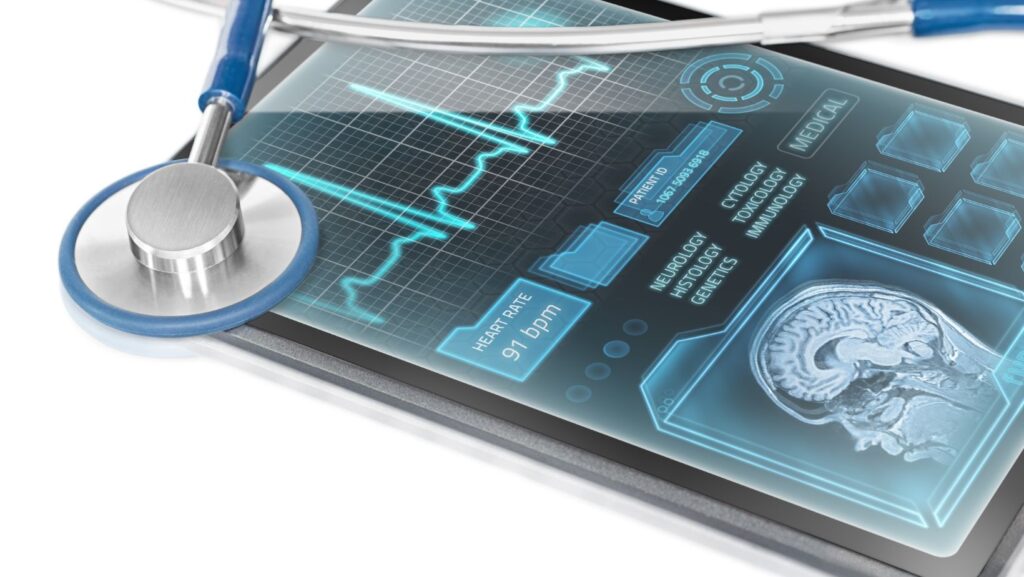
Healthcare technology is rapidly evolving, transforming patient care and medical practices. Innovations such as AI, cloud computing, telemedicine, and robotics are becoming integral parts of the healthcare system, bringing sci-fi-like advancements closer to reality. As a result, innovation in healthcare software development has become a must for any medtech or healthcare services company that wants to stay competitive.
Here’s a detailed look at the top healthcare technology trends that are shaping the industry in 2024, so far.
Artificial Intelligence (AI) and Machine Learning (ML)
AI and ML are revolutionizing healthcare by aiding in processes like tomography scan analysis and automating routine tasks such as appointment scheduling and patient record management. AI minimizes errors, saves time, and reduces patient wait times. ML helps medical professionals identify patterns and predict health outcomes, particularly in diagnosing and treating genetic diseases like cancer.
Cloud Computing
Cloud computing securely stores patient health records, allowing for easy access and data loss prevention. It enables medical professionals to make informed decisions and facilitates seamless collaboration among researchers. Cloud-based communication tools also enhance doctor-patient interactions.
Internet of Medical Things (IoMT)
The IoMT encompasses a network of connected devices that monitor and analyze health information. This technology includes wearable devices like fitness trackers and medical devices like neurostimulators and insulin pumps. These devices collect data to help healthcare professionals provide personalized treatments.
Augmented Reality (AR), Virtual Reality (VR), and Mixed Reality (MR)
AR, VR, and MR are transforming medical training, diagnosis, and treatment. VR allows trainees to interact with digital environments, improving their skills. AR aids in diagnostic imaging by overlaying 3D images on patients’ bodies, enhancing treatment accuracy. MR enables the creation of accurate virtual models, aiding in medical engineering.
Big Data Analytics
Big data analytics allows doctors to quickly analyze health records, customize treatments, and prevent adverse reactions.
On a larger scale, it helps monitor health trends, manage epidemics, and prevent disease spread. Emerging AI technologies are enabling better big data analytics than ever before.
Telemedicine and Telehealth
Telemedicine uses telecommunication to provide remote clinical and non-clinical services. It allows doctors to conduct diagnostic tests and monitor patients’ vitals remotely. This technology improves access to healthcare, especially in remote areas. Creation of AI-powered virtual assistants that are able to cater to people’s needs 24/7 and escalate issues to the right medical personnel for further checks is saving valuable time for doctors and alike.
Nanomedicine
Nanomedicine utilizes nanobots and nanoparticles for medical treatments inside the body. These tiny agents deliver medication directly to targeted cells and tissues, aiding in precision surgery, cancer treatment, and chronic disease management.
Robotics and Healthcare Automation
Robotics and automation address healthcare worker shortages by performing repetitive tasks like booking appointments and data entry. Robots can also perform delicate surgeries, reducing the risk of complications.
Organ Care Technology and Bioprinting
Organ care technology preserves vital organs for transplant, while bioprinting recreates organs and tissues using living cells and 3D printing. These advancements promise to revolutionize organ transplantation and regenerative medicine.
Smart Implants
Smart implants offer real-time data for cardiac, orthopedic, and neurological treatments. These devices monitor vital signs and provide personalized care, enhancing patient outcomes.
Telepsychiatry
Telepsychiatry expands access to mental health services through online counseling and therapy sessions.
It provides a convenient and effective way to deliver psychiatric care in today’s all remote world.
Chatbots and Virtual Healthcare Assistants
AI-powered chatbots and virtual assistants interact with patients, assist in diagnosis, prescribe medications, and provide preliminary treatments. They operate 24/7, offering health advice and reminders, enhancing patient care.
Conclusion
The integration of advanced technologies in healthcare is not only improving patient outcomes but also making healthcare services more efficient. The U.S. healthcare market is projected to grow significantly, highlighting the importance of adopting these innovations. For those looking to leverage these advancements, companies like Zartis offer healthcare software development services to help navigate this transformative landscape.














